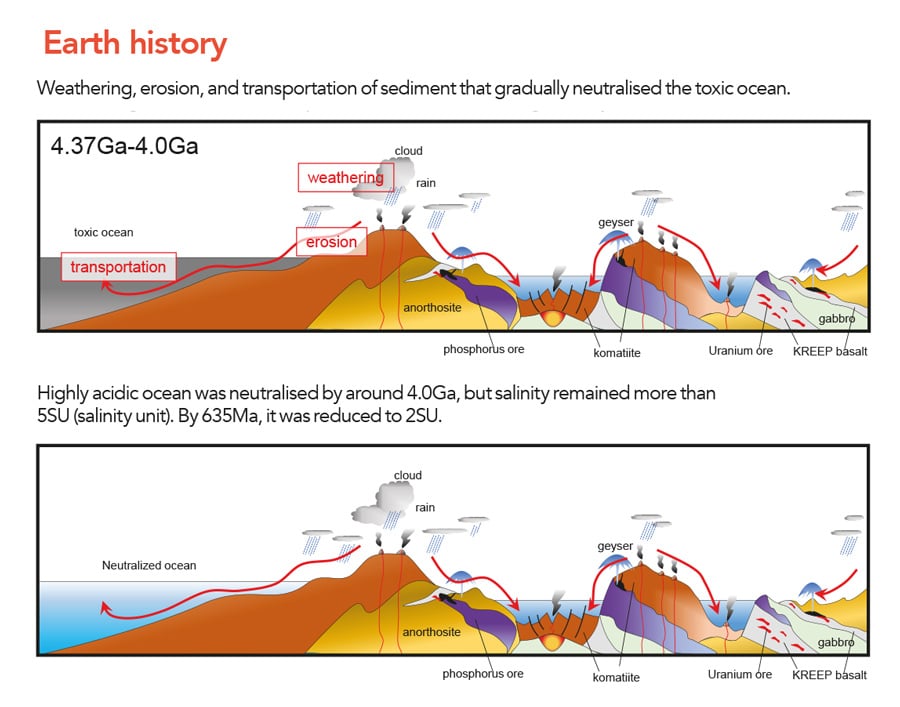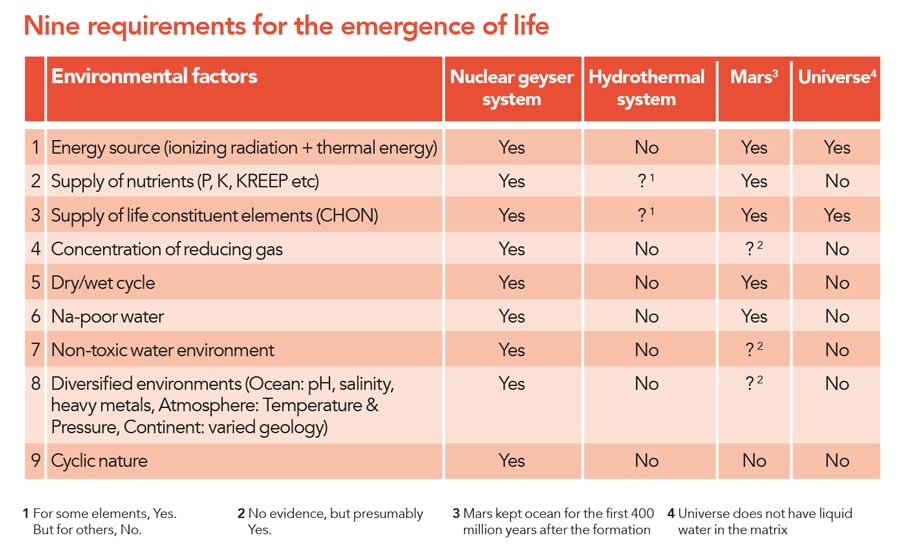The origin of life: The conditions that sparked life on Earth
The origin of Earth is a complex story. Its surface has undergone a long evolution, experiencing extreme changes over millions of years. Since its earliest accretionary phase, where gas and dust began to coalesce under the influence of gravity, it has been a dynamic planet. Bombardment from asteroids and a hot inner core meant that the earliest environment on Earth was hostile, bare rock. Geologists refer to this time, starting at Earth’s initial formation 4.6 billion years ago, as the Hadean eon. The word Hadean derives from the Greek god Hades who ruled the underworld, and is an apt analogy for the hellish environment.
Geologists have long been studying the few remnants of this time recorded in rock in the hope of finding clues about the conditions on Earth. The only records from between 4.6 and 4 billion years ago that remain are found in a hardy crystalline mineral called zircon. However, it is vital that scientists learn as much as possible about this time, as it is in these inhospitable and hellish conditions that the origin of life occurred.

Professors Shigenori Maruyama, Ken Kurokawa and Dr Toshikazu Ebisuzaki are part of a team working on the Hadean Bioscience Project, mainly based at the Earth-Life Science Institute (Tokyo Institute of Technology). The project combines scientists from a range of backgrounds, including geology, biology and physics, creating an interdisciplinary team working towards answering the fundamental question of when, where and how life was born on Earth.
The Hadean Earth
Discovering the answer as to how the very first life began on Earth has long been a challenge for scientists. Could life have spontaneously appeared on Earth? If so, how could this occur? And does this mean that other planets with similar environmental conditions also contain life?
An interdisciplinary team working towards answering the fundamental question of when, where and how life was
born on Earth.

We know that life on Earth is built around compounds that contain elements such as carbon, nitrogen, hydrogen and oxygen. Complex sequences of these elements bond together, forming the very building blocks of life. They form essential organic molecules, such as sugars, enzymes, proteins and DNA. However, these organic molecules did not naturally exist on Earth during the Hadean eon, when the first origins of life appeared. The elements required existed only in inorganic form, bound up within the rocks, atmosphere and the early ocean.

The earliest Earth was a ‘naked planet;’ the Hadean Bioscience colleagues describe it as having no ocean or atmosphere when it first formed. These eventually appeared around 4.37 billion years ago after Earth had been pelted by aqueous asteroid material. Once there was liquid water and an atmosphere, there was a greater chance for prebiotic life to form (the chemical precursors to life on Earth). The first traces of life recorded on Earth are thought to be as old as 4.2 billion years, indicating that life may have evolved within 200 million years after the first appearance of liquid water.

Requirements for early life
We know that all the key elements for life are found on Earth, but they do not easily form organic compounds. Early experiments during the 1950s showed that it was possible for amino acids to form in water condensation within experimental conditions that mimicked the atmosphere of the early Earth. However, for this to occur, a powerful energy source was required. The input of energy caused chemical reactions capable of creating compounds based on hydrogen, carbon and nitrogen that would eventually form organic molecules.
The Hadean Bioscience researchers suggest that in order to understand how life began on Earth, we need to understand the specific environmental requirements that must be satisfied to allow this to occur. They identified nine specific conditions and unless all these environmental requirements are met, life cannot be born.
The nuclear geyser
There have been many theories as to how life began. One of the most popular was put forward by Darwin himself, who suggested that a ‘warm little pond’ could have been the most likely location for life to begin. Another popular theory states that hydrothermal vents along mid-ocean ridges would be an ideal location for the precursors of life to develop, whilst others propose that life was carried here from elsewhere in the Universe and delivered during an asteroid impact. By identifying the essential requirements for life, the Hadean Bioscience colleagues have been able to identify the most likely location for life to have begun.

Nuclear geysers are a phenomenon we do not see on present-day Earth. During the Hadean eon, some radioactive elements were much more common on the Earth’s surface. Radioactive elements, such as uranium, have unstable isotopes which break down over time and release radiation. The charged particles that form radiation can react with the surrounding water, activating inert molecules and atoms and producing a flow of electrons that drive further chemical reactions. Water is heated by the natural nuclear reactor, and is periodically sprayed out onto the Earth’s surface in a similar manner to the geysers we see on Earth today.
… understanding these key requirements for the formation on life on Earth and how they define the location for its earliest beginnings, we can begin to understand where we might find life
beyond our planet.
The appearance of first life
The Hadean Bioscience researchers have been able to show that the nuclear geyser is the only theory for the location of first life that fits all nine essential requirements:

- For prebiotic life to begin, a powerful energy source is required. Energy from the Sun alone is not enough to break down inorganic compounds such as nitrogen (N2), carbon dioxide (CO2) and water (H2O) and convert them to complex organic molecules. However, a natural nuclear reactor would provide more than enough energy to drive the required reactions.
- A supply of major elements is another condition for the formation of life, as most organisms on earth are made up of carbon, hydrogen, oxygen and nitrogen. The early Earth crust, along with the atmosphere and ocean, can supply these.
- As well as the elements that form the building blocks of organic compounds, there must also be a ready supply of the nutrients that sustain life. The nutrient source on early Hadean Earth would have been the rocks on the Earth’s surface, which were rich in iron and phosphorus as well as rarer elements like potassium and uranium.
- A high concentration of gases containing compounds such as ammonia and methane is another key requirement. An enclosed space, such as an underground chamber occurring in the plumbing of a nuclear geyser, would collect a sufficient concentration of these gasses.
- The team have also identified that dry-wet cycles are another essential environmental condition for the emergence of life. Alternating between hydration and dehydration can generate more complex organic molecules from amino acids, such as RNA.
- For life to begin, water must be clean and non-toxic. The early oceans were highly acidic and very salty, and life would not have emerged nor survived here. This suggests that life would have formed in a watery environment on land, such as pool or wetland.
- Water must also be poor in sodium and rich in potassium. We know this as modern cells contain little sodium, suggesting that life formed in an environment where this was relatively unavailable.
- A cycle between day and night is another vital condition for the birth of life. Day-night cycles allow variations in temperature, with low and high temperatures driving different types of reactions, and encouraging self-replication of DNA sequences.
- Finally, a diverse environment is necessary to emerge life. Variations in pH, salinity and temperature will help to drive different types of reactions, leading to more complex and varying organic molecules. Diverse environments would occur across the Earth’s landmass through plate tectonics, but not within its oceans.

Life beyond Earth
The team have been able to show that a nuclear geyser is the most likely location to be the birthplace of life, rather than at a hydrothermal vent with toxic oceans, a lack of nutrients and not enough energy to drive the reactions that generate organic molecules. A nuclear geyser system is the only proposed location that meets all the conditions. By understanding these key requirements for the formation of life on Earth and how they define the location for its earliest beginnings, we can begin to understand where we might find life beyond our planet.
Personal Response
What first inspired you to investigate the origins of life on Earth?
<=”acceptedAnswer”> Prof Maruyama: I have long been involved in research into the history of Earth and life. The mystery of the origin of Earth and the origin of life itself has not yet been unravelled. I decided to tackle this mystery by drawing upon our knowledge of world geology, the history of the Earth, and co-evolution of Earth and life. A key concept is that the environment drives life’s emergence and evolution. The Hadean Bioscience CG movie series “The whole history of the Earth and life” is now showing on YouTube: www.youtube.com/c/HadeanBioscience